Westpac and Australian Legal Frameworks: A Trade Report
VerifiedAdded on 2023/01/20
|12
|2828
|87
Report
AI Summary
This report provides an executive summary and in-depth analysis of Westpac Banking Corporation, evaluating its operations and identifying its industry. The report examines Westpac's headquarters, employee count, and the key provisions of the Australian legislative framework, including taxation laws, banking regulations, the Competition and Consumer Act, and the Fair Trading Act. Furthermore, the report identifies and analyzes key treaties, conventions, and agreements, such as the ASEAN-Australia-New Zealand Free Trade Area (AANZFTA), the China-Australia Free Trade Agreement (ChAFTA), and the Australia-United States Free Trade Agreement (AUSFTA), to understand their impact on Westpac's products and services, highlighting both opportunities and obstacles. The analysis covers how these regulations and agreements shape Westpac's business practices and expansion strategies within Australia and internationally.

Legal Aspects of
International Trade
and Enterprise
2019
International Trade
and Enterprise
2019
Paraphrase This Document
Need a fresh take? Get an instant paraphrase of this document with our AI Paraphraser
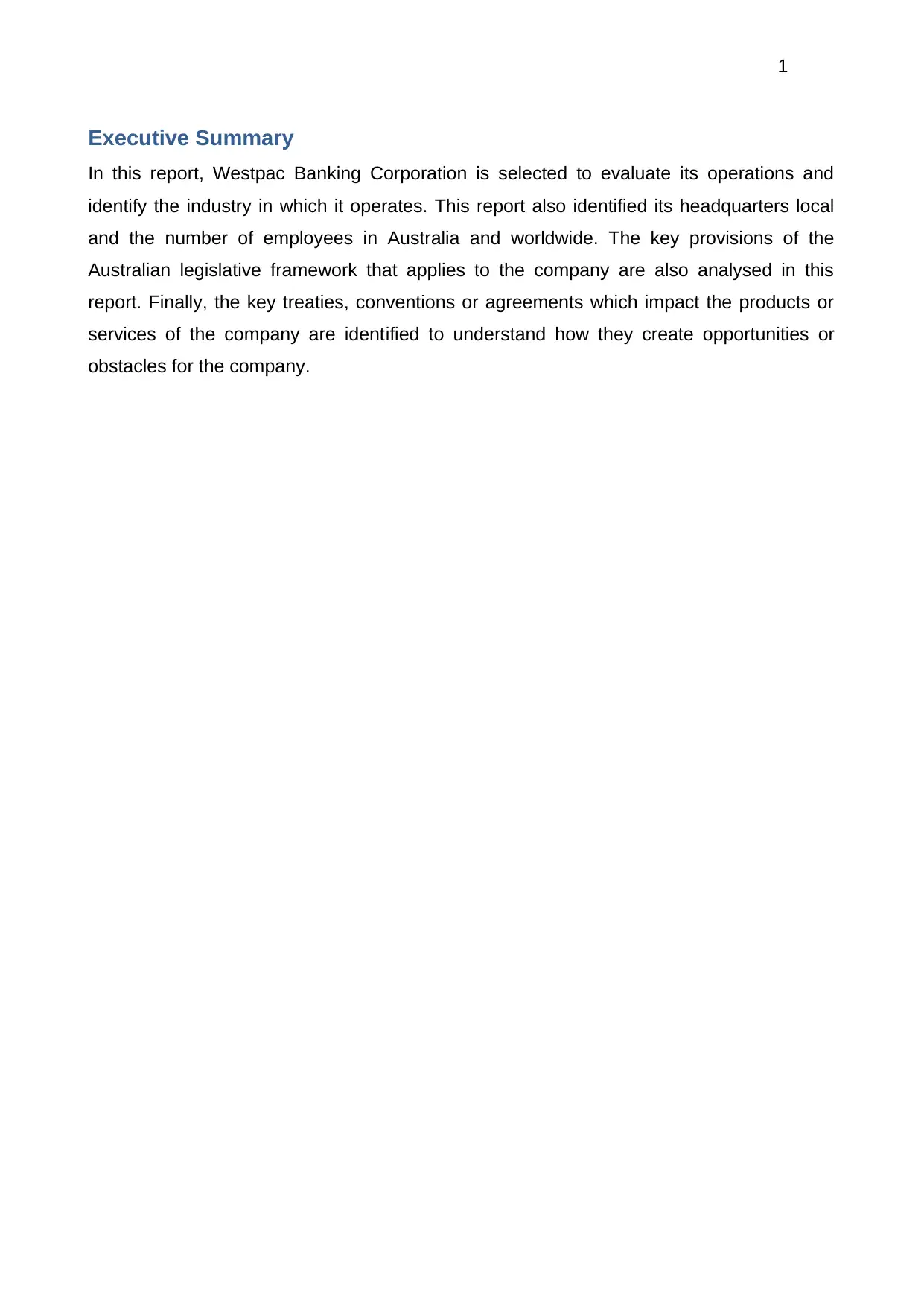
1
Executive Summary
In this report, Westpac Banking Corporation is selected to evaluate its operations and
identify the industry in which it operates. This report also identified its headquarters local
and the number of employees in Australia and worldwide. The key provisions of the
Australian legislative framework that applies to the company are also analysed in this
report. Finally, the key treaties, conventions or agreements which impact the products or
services of the company are identified to understand how they create opportunities or
obstacles for the company.
Executive Summary
In this report, Westpac Banking Corporation is selected to evaluate its operations and
identify the industry in which it operates. This report also identified its headquarters local
and the number of employees in Australia and worldwide. The key provisions of the
Australian legislative framework that applies to the company are also analysed in this
report. Finally, the key treaties, conventions or agreements which impact the products or
services of the company are identified to understand how they create opportunities or
obstacles for the company.

2
Table of Contents
Answer-1................................................................................................................................3
Answer-2................................................................................................................................4
Answer-3................................................................................................................................6
References.............................................................................................................................8
Table of Contents
Answer-1................................................................................................................................3
Answer-2................................................................................................................................4
Answer-3................................................................................................................................6
References.............................................................................................................................8
⊘ This is a preview!⊘
Do you want full access?
Subscribe today to unlock all pages.

Trusted by 1+ million students worldwide
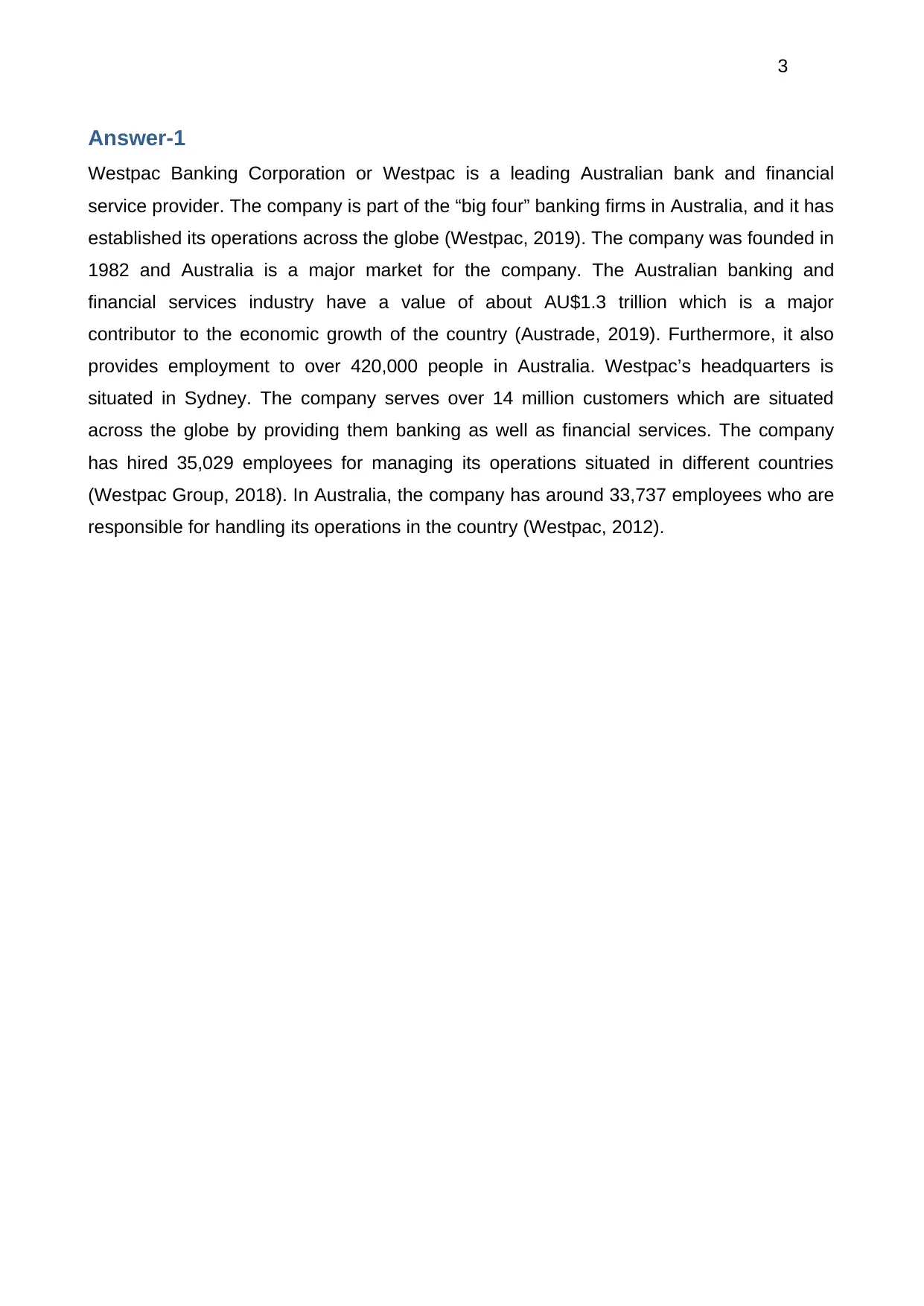
3
Answer-1
Westpac Banking Corporation or Westpac is a leading Australian bank and financial
service provider. The company is part of the “big four” banking firms in Australia, and it has
established its operations across the globe (Westpac, 2019). The company was founded in
1982 and Australia is a major market for the company. The Australian banking and
financial services industry have a value of about AU$1.3 trillion which is a major
contributor to the economic growth of the country (Austrade, 2019). Furthermore, it also
provides employment to over 420,000 people in Australia. Westpac’s headquarters is
situated in Sydney. The company serves over 14 million customers which are situated
across the globe by providing them banking as well as financial services. The company
has hired 35,029 employees for managing its operations situated in different countries
(Westpac Group, 2018). In Australia, the company has around 33,737 employees who are
responsible for handling its operations in the country (Westpac, 2012).
Answer-1
Westpac Banking Corporation or Westpac is a leading Australian bank and financial
service provider. The company is part of the “big four” banking firms in Australia, and it has
established its operations across the globe (Westpac, 2019). The company was founded in
1982 and Australia is a major market for the company. The Australian banking and
financial services industry have a value of about AU$1.3 trillion which is a major
contributor to the economic growth of the country (Austrade, 2019). Furthermore, it also
provides employment to over 420,000 people in Australia. Westpac’s headquarters is
situated in Sydney. The company serves over 14 million customers which are situated
across the globe by providing them banking as well as financial services. The company
has hired 35,029 employees for managing its operations situated in different countries
(Westpac Group, 2018). In Australia, the company has around 33,737 employees who are
responsible for handling its operations in the country (Westpac, 2012).
Paraphrase This Document
Need a fresh take? Get an instant paraphrase of this document with our AI Paraphraser

4
Answer-2
The objective of implementation of the legislative framework in a country is to make sure
that companies comply with these guidelines which are crucial to achieve sustained
growth in the country. These regulatory frameworks set guidelines for organisations that
are operating in the country to make sure that they did not engage in illegal or immoral
practices in order to maximise their profits (Dixon, 2013). These guidelines also protect the
rights of customers and employees by making sure that these companies are bound by a
specific legislative framework that guides their actions and imposes obligations on the
directors and members of the company to take into consideration the interest of other
stakeholders such as customers and employees. Following are different regulatory policies
which apply on Westpac when it manages its operations in Australia.
Taxation laws: Westpac has to comply with the guidelines given by the Australian
government under the taxation laws which are applied to the operations of the company.
The profits generated by Westpac from its operations in Australia comes within the scope
of taxation policies under which the company is bound to make sure that it takes corrective
measures to discharge its tax obligations. For example, the company has to pay a
corporate tax in Australia on its profits and the current rate of the corporate tax rate in
Australia is 30 per cent (Trading Economics, 2019). The tax is imposed on the operations
of Westpac which it conducts in Australia. Another relevant taxation law in this regarding is
the Goods and Services Tax (GST). Since Westpac offers its services in Australia, it has to
pay GST to the government. The current rate of GST in Australia is 10 per cent which is
applied to companies such as Westpac (Business, 2018).
Banking Regulations: Australia has a competitive, profitable and sophisticated financial
sector due to a strong regulatory system. There are various banking regulations imposed
by the Australian government which applies to the operations of Westpac. For example,
the Banking Act 1959 provides various provisions regarding banking corporations
operating in the country (Wilson, 2012). Westpac has to acquire a bank licence under this
Act to conduct its operations and manage its branches in Australia. Furthermore, the
company has to work according to the guidelines issued by the Australian Securities and
Investments Commission (ASIC) and the Australian Prudential Regulation Australia
(APRA). Westpac has to submit relevant documents to these authorities as per their
requests to make sure that it did not breach any guidelines (Lui, 2016). The Reserve bank
of Australia is another major involvement in the banking regulatory framework of Australia
Answer-2
The objective of implementation of the legislative framework in a country is to make sure
that companies comply with these guidelines which are crucial to achieve sustained
growth in the country. These regulatory frameworks set guidelines for organisations that
are operating in the country to make sure that they did not engage in illegal or immoral
practices in order to maximise their profits (Dixon, 2013). These guidelines also protect the
rights of customers and employees by making sure that these companies are bound by a
specific legislative framework that guides their actions and imposes obligations on the
directors and members of the company to take into consideration the interest of other
stakeholders such as customers and employees. Following are different regulatory policies
which apply on Westpac when it manages its operations in Australia.
Taxation laws: Westpac has to comply with the guidelines given by the Australian
government under the taxation laws which are applied to the operations of the company.
The profits generated by Westpac from its operations in Australia comes within the scope
of taxation policies under which the company is bound to make sure that it takes corrective
measures to discharge its tax obligations. For example, the company has to pay a
corporate tax in Australia on its profits and the current rate of the corporate tax rate in
Australia is 30 per cent (Trading Economics, 2019). The tax is imposed on the operations
of Westpac which it conducts in Australia. Another relevant taxation law in this regarding is
the Goods and Services Tax (GST). Since Westpac offers its services in Australia, it has to
pay GST to the government. The current rate of GST in Australia is 10 per cent which is
applied to companies such as Westpac (Business, 2018).
Banking Regulations: Australia has a competitive, profitable and sophisticated financial
sector due to a strong regulatory system. There are various banking regulations imposed
by the Australian government which applies to the operations of Westpac. For example,
the Banking Act 1959 provides various provisions regarding banking corporations
operating in the country (Wilson, 2012). Westpac has to acquire a bank licence under this
Act to conduct its operations and manage its branches in Australia. Furthermore, the
company has to work according to the guidelines issued by the Australian Securities and
Investments Commission (ASIC) and the Australian Prudential Regulation Australia
(APRA). Westpac has to submit relevant documents to these authorities as per their
requests to make sure that it did not breach any guidelines (Lui, 2016). The Reserve bank
of Australia is another major involvement in the banking regulatory framework of Australia
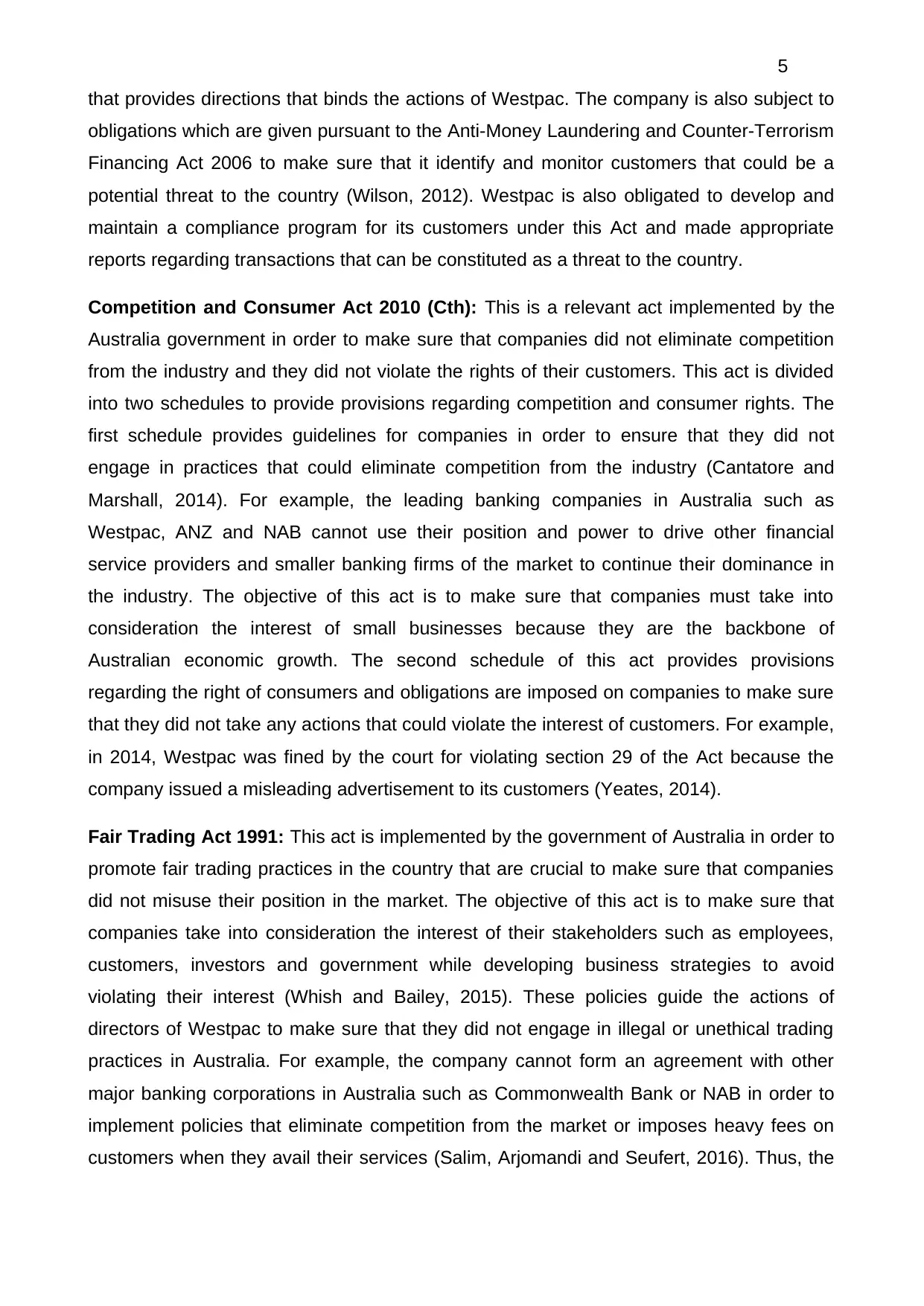
5
that provides directions that binds the actions of Westpac. The company is also subject to
obligations which are given pursuant to the Anti-Money Laundering and Counter-Terrorism
Financing Act 2006 to make sure that it identify and monitor customers that could be a
potential threat to the country (Wilson, 2012). Westpac is also obligated to develop and
maintain a compliance program for its customers under this Act and made appropriate
reports regarding transactions that can be constituted as a threat to the country.
Competition and Consumer Act 2010 (Cth): This is a relevant act implemented by the
Australia government in order to make sure that companies did not eliminate competition
from the industry and they did not violate the rights of their customers. This act is divided
into two schedules to provide provisions regarding competition and consumer rights. The
first schedule provides guidelines for companies in order to ensure that they did not
engage in practices that could eliminate competition from the industry (Cantatore and
Marshall, 2014). For example, the leading banking companies in Australia such as
Westpac, ANZ and NAB cannot use their position and power to drive other financial
service providers and smaller banking firms of the market to continue their dominance in
the industry. The objective of this act is to make sure that companies must take into
consideration the interest of small businesses because they are the backbone of
Australian economic growth. The second schedule of this act provides provisions
regarding the right of consumers and obligations are imposed on companies to make sure
that they did not take any actions that could violate the interest of customers. For example,
in 2014, Westpac was fined by the court for violating section 29 of the Act because the
company issued a misleading advertisement to its customers (Yeates, 2014).
Fair Trading Act 1991: This act is implemented by the government of Australia in order to
promote fair trading practices in the country that are crucial to make sure that companies
did not misuse their position in the market. The objective of this act is to make sure that
companies take into consideration the interest of their stakeholders such as employees,
customers, investors and government while developing business strategies to avoid
violating their interest (Whish and Bailey, 2015). These policies guide the actions of
directors of Westpac to make sure that they did not engage in illegal or unethical trading
practices in Australia. For example, the company cannot form an agreement with other
major banking corporations in Australia such as Commonwealth Bank or NAB in order to
implement policies that eliminate competition from the market or imposes heavy fees on
customers when they avail their services (Salim, Arjomandi and Seufert, 2016). Thus, the
that provides directions that binds the actions of Westpac. The company is also subject to
obligations which are given pursuant to the Anti-Money Laundering and Counter-Terrorism
Financing Act 2006 to make sure that it identify and monitor customers that could be a
potential threat to the country (Wilson, 2012). Westpac is also obligated to develop and
maintain a compliance program for its customers under this Act and made appropriate
reports regarding transactions that can be constituted as a threat to the country.
Competition and Consumer Act 2010 (Cth): This is a relevant act implemented by the
Australia government in order to make sure that companies did not eliminate competition
from the industry and they did not violate the rights of their customers. This act is divided
into two schedules to provide provisions regarding competition and consumer rights. The
first schedule provides guidelines for companies in order to ensure that they did not
engage in practices that could eliminate competition from the industry (Cantatore and
Marshall, 2014). For example, the leading banking companies in Australia such as
Westpac, ANZ and NAB cannot use their position and power to drive other financial
service providers and smaller banking firms of the market to continue their dominance in
the industry. The objective of this act is to make sure that companies must take into
consideration the interest of small businesses because they are the backbone of
Australian economic growth. The second schedule of this act provides provisions
regarding the right of consumers and obligations are imposed on companies to make sure
that they did not take any actions that could violate the interest of customers. For example,
in 2014, Westpac was fined by the court for violating section 29 of the Act because the
company issued a misleading advertisement to its customers (Yeates, 2014).
Fair Trading Act 1991: This act is implemented by the government of Australia in order to
promote fair trading practices in the country that are crucial to make sure that companies
did not misuse their position in the market. The objective of this act is to make sure that
companies take into consideration the interest of their stakeholders such as employees,
customers, investors and government while developing business strategies to avoid
violating their interest (Whish and Bailey, 2015). These policies guide the actions of
directors of Westpac to make sure that they did not engage in illegal or unethical trading
practices in Australia. For example, the company cannot form an agreement with other
major banking corporations in Australia such as Commonwealth Bank or NAB in order to
implement policies that eliminate competition from the market or imposes heavy fees on
customers when they avail their services (Salim, Arjomandi and Seufert, 2016). Thus, the
⊘ This is a preview!⊘
Do you want full access?
Subscribe today to unlock all pages.

Trusted by 1+ million students worldwide

6
directors of the company have to comply with these guidelines to make sure that they did
not engage in illegal or unethical practices.
directors of the company have to comply with these guidelines to make sure that they did
not engage in illegal or unethical practices.
Paraphrase This Document
Need a fresh take? Get an instant paraphrase of this document with our AI Paraphraser

7
Answer-3
The company that is operating in Australia are bind by its regulatory framework; however,
the treaties, conventions and agreements made by the country also apply on their
business which creates potential threats and opportunities for them. The provisions gave
under these treaties and agreements resulted in affecting the products or services which
are offered by multinational corporations in Australia. Therefore, it is important that the
management of companies must take into consideration these factors or else they could
face potential legal challenges that resulted in affecting their operations and profitability
(Widdows, 2017). Westpac is also affected by these provisions since the company
operates in Australia and many other countries. Thus, the treaties, conventions and
agreements which are formed between the government of Australia and other nations
create new business expansion opportunities for Westpac. The Australian government has
also created a number of Free Trade Agreements (FTAs) with other nations that assist
foreign and domestic companies in establishing their operations outside their home
country to increase their customer base and expand their profitability (Song and Yuan,
2012).
ASEAN-Australia-New Zealand Free Trade Area (AANZFTA): This is an important
agreement that is formed between the government of Australia and New Zealand that
opens up new opportunities for Westpac. This agreement comes into force in January
2010 in which the government introduced new provisions that were focused on building
new trading relationships and giving opportunities to corporations to expand their
operations in both nations (Bano, Takahashi and Scrimgeour, 2013). Through this
agreement, the governments took measures in order to extensively reduce tariff or duties
which companies have to otherwise pay when they import or export their products in the
country or offer their services in either nation. The government also created greater
certainty for investors and service suppliers such as Westpac to make sure that they have
to deal with less legal formalities when they expand their operations in the country. The
government also continue to offer new amendments in these provisions and more counties
have become signatories in this agreement such as Myanmar, Indonesia, Singapore,
Vietnam, Thailand and Philippines that resulted in opening new trading grounds of
Australian as well as foreign companies (Ishido, 2012). Similarly, Westpac is able to
effectively conduct its operations and expand them in markets such as New Zealand
without having to deal with stricter legal formalities that made the process slower. The
Answer-3
The company that is operating in Australia are bind by its regulatory framework; however,
the treaties, conventions and agreements made by the country also apply on their
business which creates potential threats and opportunities for them. The provisions gave
under these treaties and agreements resulted in affecting the products or services which
are offered by multinational corporations in Australia. Therefore, it is important that the
management of companies must take into consideration these factors or else they could
face potential legal challenges that resulted in affecting their operations and profitability
(Widdows, 2017). Westpac is also affected by these provisions since the company
operates in Australia and many other countries. Thus, the treaties, conventions and
agreements which are formed between the government of Australia and other nations
create new business expansion opportunities for Westpac. The Australian government has
also created a number of Free Trade Agreements (FTAs) with other nations that assist
foreign and domestic companies in establishing their operations outside their home
country to increase their customer base and expand their profitability (Song and Yuan,
2012).
ASEAN-Australia-New Zealand Free Trade Area (AANZFTA): This is an important
agreement that is formed between the government of Australia and New Zealand that
opens up new opportunities for Westpac. This agreement comes into force in January
2010 in which the government introduced new provisions that were focused on building
new trading relationships and giving opportunities to corporations to expand their
operations in both nations (Bano, Takahashi and Scrimgeour, 2013). Through this
agreement, the governments took measures in order to extensively reduce tariff or duties
which companies have to otherwise pay when they import or export their products in the
country or offer their services in either nation. The government also created greater
certainty for investors and service suppliers such as Westpac to make sure that they have
to deal with less legal formalities when they expand their operations in the country. The
government also continue to offer new amendments in these provisions and more counties
have become signatories in this agreement such as Myanmar, Indonesia, Singapore,
Vietnam, Thailand and Philippines that resulted in opening new trading grounds of
Australian as well as foreign companies (Ishido, 2012). Similarly, Westpac is able to
effectively conduct its operations and expand them in markets such as New Zealand
without having to deal with stricter legal formalities that made the process slower. The
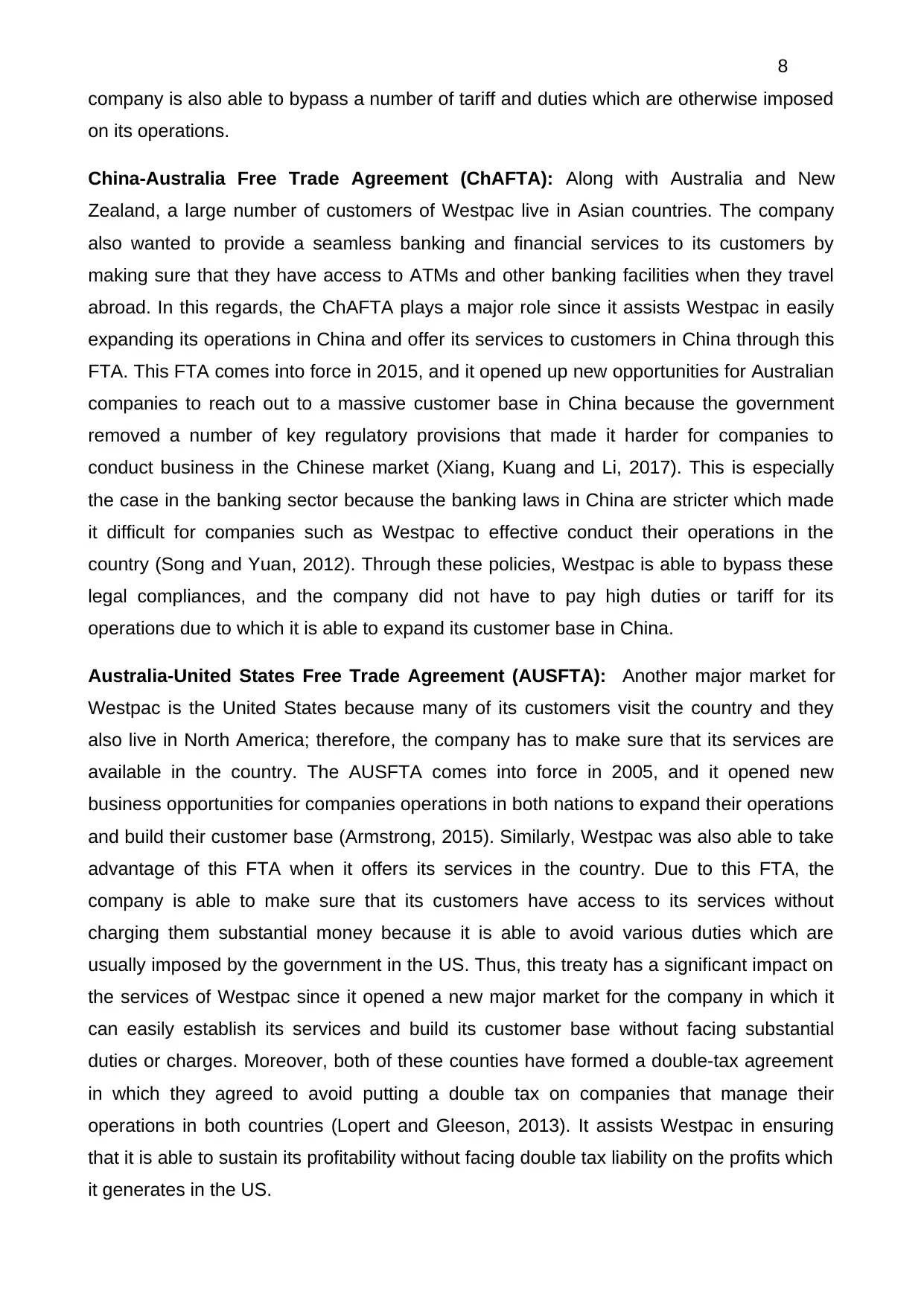
8
company is also able to bypass a number of tariff and duties which are otherwise imposed
on its operations.
China-Australia Free Trade Agreement (ChAFTA): Along with Australia and New
Zealand, a large number of customers of Westpac live in Asian countries. The company
also wanted to provide a seamless banking and financial services to its customers by
making sure that they have access to ATMs and other banking facilities when they travel
abroad. In this regards, the ChAFTA plays a major role since it assists Westpac in easily
expanding its operations in China and offer its services to customers in China through this
FTA. This FTA comes into force in 2015, and it opened up new opportunities for Australian
companies to reach out to a massive customer base in China because the government
removed a number of key regulatory provisions that made it harder for companies to
conduct business in the Chinese market (Xiang, Kuang and Li, 2017). This is especially
the case in the banking sector because the banking laws in China are stricter which made
it difficult for companies such as Westpac to effective conduct their operations in the
country (Song and Yuan, 2012). Through these policies, Westpac is able to bypass these
legal compliances, and the company did not have to pay high duties or tariff for its
operations due to which it is able to expand its customer base in China.
Australia-United States Free Trade Agreement (AUSFTA): Another major market for
Westpac is the United States because many of its customers visit the country and they
also live in North America; therefore, the company has to make sure that its services are
available in the country. The AUSFTA comes into force in 2005, and it opened new
business opportunities for companies operations in both nations to expand their operations
and build their customer base (Armstrong, 2015). Similarly, Westpac was also able to take
advantage of this FTA when it offers its services in the country. Due to this FTA, the
company is able to make sure that its customers have access to its services without
charging them substantial money because it is able to avoid various duties which are
usually imposed by the government in the US. Thus, this treaty has a significant impact on
the services of Westpac since it opened a new major market for the company in which it
can easily establish its services and build its customer base without facing substantial
duties or charges. Moreover, both of these counties have formed a double-tax agreement
in which they agreed to avoid putting a double tax on companies that manage their
operations in both countries (Lopert and Gleeson, 2013). It assists Westpac in ensuring
that it is able to sustain its profitability without facing double tax liability on the profits which
it generates in the US.
company is also able to bypass a number of tariff and duties which are otherwise imposed
on its operations.
China-Australia Free Trade Agreement (ChAFTA): Along with Australia and New
Zealand, a large number of customers of Westpac live in Asian countries. The company
also wanted to provide a seamless banking and financial services to its customers by
making sure that they have access to ATMs and other banking facilities when they travel
abroad. In this regards, the ChAFTA plays a major role since it assists Westpac in easily
expanding its operations in China and offer its services to customers in China through this
FTA. This FTA comes into force in 2015, and it opened up new opportunities for Australian
companies to reach out to a massive customer base in China because the government
removed a number of key regulatory provisions that made it harder for companies to
conduct business in the Chinese market (Xiang, Kuang and Li, 2017). This is especially
the case in the banking sector because the banking laws in China are stricter which made
it difficult for companies such as Westpac to effective conduct their operations in the
country (Song and Yuan, 2012). Through these policies, Westpac is able to bypass these
legal compliances, and the company did not have to pay high duties or tariff for its
operations due to which it is able to expand its customer base in China.
Australia-United States Free Trade Agreement (AUSFTA): Another major market for
Westpac is the United States because many of its customers visit the country and they
also live in North America; therefore, the company has to make sure that its services are
available in the country. The AUSFTA comes into force in 2005, and it opened new
business opportunities for companies operations in both nations to expand their operations
and build their customer base (Armstrong, 2015). Similarly, Westpac was also able to take
advantage of this FTA when it offers its services in the country. Due to this FTA, the
company is able to make sure that its customers have access to its services without
charging them substantial money because it is able to avoid various duties which are
usually imposed by the government in the US. Thus, this treaty has a significant impact on
the services of Westpac since it opened a new major market for the company in which it
can easily establish its services and build its customer base without facing substantial
duties or charges. Moreover, both of these counties have formed a double-tax agreement
in which they agreed to avoid putting a double tax on companies that manage their
operations in both countries (Lopert and Gleeson, 2013). It assists Westpac in ensuring
that it is able to sustain its profitability without facing double tax liability on the profits which
it generates in the US.
⊘ This is a preview!⊘
Do you want full access?
Subscribe today to unlock all pages.

Trusted by 1+ million students worldwide

9
Paraphrase This Document
Need a fresh take? Get an instant paraphrase of this document with our AI Paraphraser

10
References
Armstrong, S. (2015) The economic impact of the Australia–US free trade
agreement. Australian Journal of International Affairs, 69(5), pp.513-537.
Austrade. (2019) Financial Services. [Online] Available at
https://www.austrade.gov.au/International/Buy/Australian-industry-capabilities/financial-
services [accessed on 23/04/2019].
Bano, S., Takahashi, Y. and Scrimgeour, F. (2013) ASEAN-New Zealand trade relations
and trade potential: Evidence and analysis. Journal of Economic Integration, pp.144-182.
Business. (2018) Goods and services tax (GST). [Online] Available at
https://www.business.gov.au/new-to-business-essentials/series-three/goods-and-services-
tax-gst [accessed on 23/04/2019].
Cantatore, F. and Marshall, B. (2014) Businesses are People Too? Anomalies in Widening
the Ambits of ‘Consumer’Under Consumer Credit Law. Australian Business Law
Review, 42, pp.113-23.
Dixon, M. (2013) Textbook on international law. Oxford: Oxford University Press.
Ishido, H. (2012) Liberalization of Trade in Services Under ASEAN n FTAs: A Mapping
Exercise. Journal of East Asian Economic Integration, 16(2), pp.155-204.
Lopert, R. and Gleeson, D. (2013) The high price of “free” trade: US trade agreements and
access to medicines. The Journal of Law, Medicine & Ethics, 41(1), pp.199-223.
Lui, A. (2016) Financial stability and prudential regulation: a comparative approach to the
UK, US, Canada, Australia and Germany. Abingdon: Routledge.
Salim, R., Arjomandi, A. and Seufert, J.H. (2016) Does corporate governance affect
Australian banks' performance?. Journal of International Financial Markets, Institutions
and Money, 43, pp.113-125.
Trading Economics. (2019) Australia Corporate Tax Rate. [Online] Available at
https://tradingeconomics.com/australia/corporate-tax-rate [accessed on 23/04/2019].
References
Armstrong, S. (2015) The economic impact of the Australia–US free trade
agreement. Australian Journal of International Affairs, 69(5), pp.513-537.
Austrade. (2019) Financial Services. [Online] Available at
https://www.austrade.gov.au/International/Buy/Australian-industry-capabilities/financial-
services [accessed on 23/04/2019].
Bano, S., Takahashi, Y. and Scrimgeour, F. (2013) ASEAN-New Zealand trade relations
and trade potential: Evidence and analysis. Journal of Economic Integration, pp.144-182.
Business. (2018) Goods and services tax (GST). [Online] Available at
https://www.business.gov.au/new-to-business-essentials/series-three/goods-and-services-
tax-gst [accessed on 23/04/2019].
Cantatore, F. and Marshall, B. (2014) Businesses are People Too? Anomalies in Widening
the Ambits of ‘Consumer’Under Consumer Credit Law. Australian Business Law
Review, 42, pp.113-23.
Dixon, M. (2013) Textbook on international law. Oxford: Oxford University Press.
Ishido, H. (2012) Liberalization of Trade in Services Under ASEAN n FTAs: A Mapping
Exercise. Journal of East Asian Economic Integration, 16(2), pp.155-204.
Lopert, R. and Gleeson, D. (2013) The high price of “free” trade: US trade agreements and
access to medicines. The Journal of Law, Medicine & Ethics, 41(1), pp.199-223.
Lui, A. (2016) Financial stability and prudential regulation: a comparative approach to the
UK, US, Canada, Australia and Germany. Abingdon: Routledge.
Salim, R., Arjomandi, A. and Seufert, J.H. (2016) Does corporate governance affect
Australian banks' performance?. Journal of International Financial Markets, Institutions
and Money, 43, pp.113-125.
Trading Economics. (2019) Australia Corporate Tax Rate. [Online] Available at
https://tradingeconomics.com/australia/corporate-tax-rate [accessed on 23/04/2019].
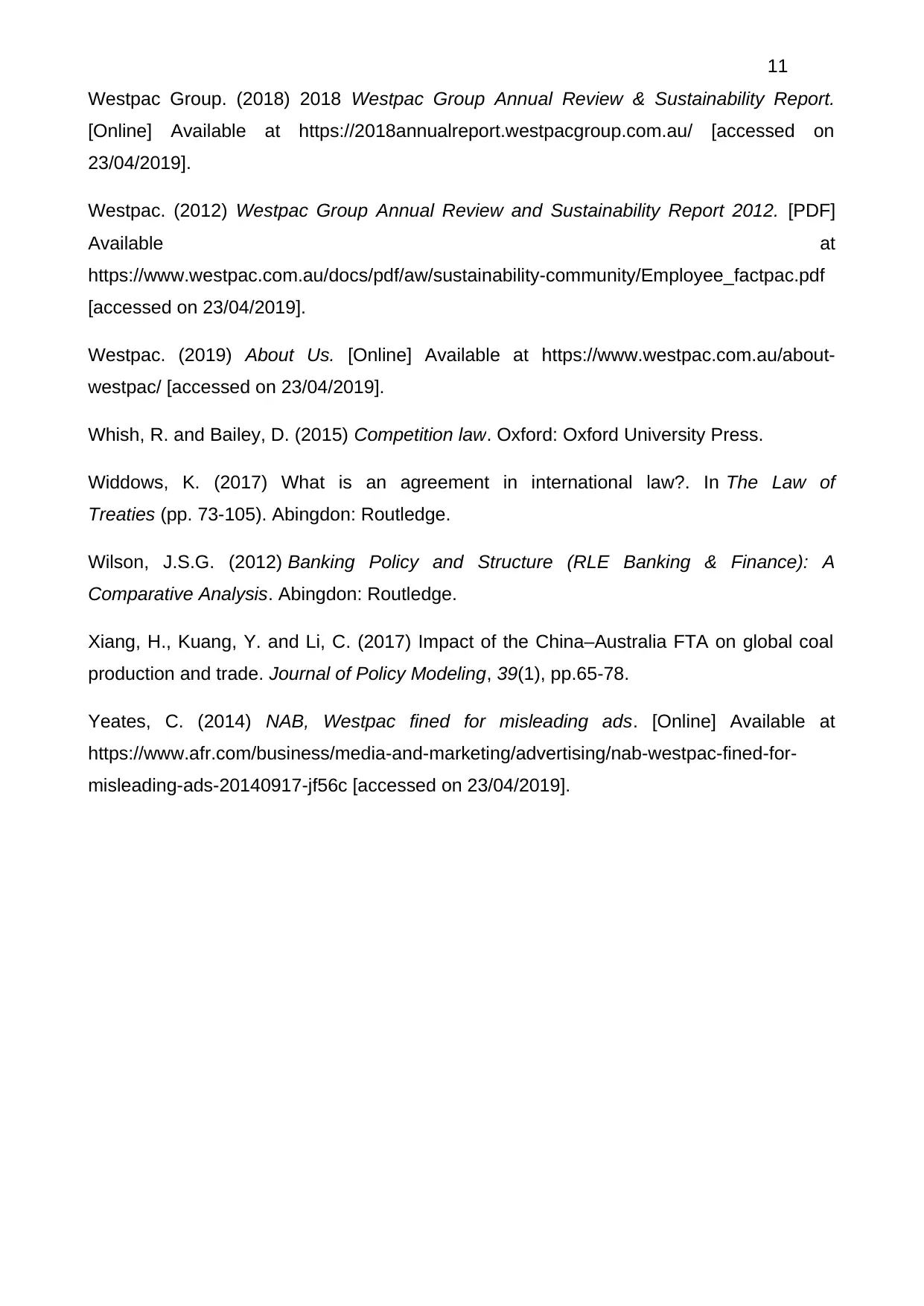
11
Westpac Group. (2018) 2018 Westpac Group Annual Review & Sustainability Report.
[Online] Available at https://2018annualreport.westpacgroup.com.au/ [accessed on
23/04/2019].
Westpac. (2012) Westpac Group Annual Review and Sustainability Report 2012. [PDF]
Available at
https://www.westpac.com.au/docs/pdf/aw/sustainability-community/Employee_factpac.pdf
[accessed on 23/04/2019].
Westpac. (2019) About Us. [Online] Available at https://www.westpac.com.au/about-
westpac/ [accessed on 23/04/2019].
Whish, R. and Bailey, D. (2015) Competition law. Oxford: Oxford University Press.
Widdows, K. (2017) What is an agreement in international law?. In The Law of
Treaties (pp. 73-105). Abingdon: Routledge.
Wilson, J.S.G. (2012) Banking Policy and Structure (RLE Banking & Finance): A
Comparative Analysis. Abingdon: Routledge.
Xiang, H., Kuang, Y. and Li, C. (2017) Impact of the China–Australia FTA on global coal
production and trade. Journal of Policy Modeling, 39(1), pp.65-78.
Yeates, C. (2014) NAB, Westpac fined for misleading ads. [Online] Available at
https://www.afr.com/business/media-and-marketing/advertising/nab-westpac-fined-for-
misleading-ads-20140917-jf56c [accessed on 23/04/2019].
Westpac Group. (2018) 2018 Westpac Group Annual Review & Sustainability Report.
[Online] Available at https://2018annualreport.westpacgroup.com.au/ [accessed on
23/04/2019].
Westpac. (2012) Westpac Group Annual Review and Sustainability Report 2012. [PDF]
Available at
https://www.westpac.com.au/docs/pdf/aw/sustainability-community/Employee_factpac.pdf
[accessed on 23/04/2019].
Westpac. (2019) About Us. [Online] Available at https://www.westpac.com.au/about-
westpac/ [accessed on 23/04/2019].
Whish, R. and Bailey, D. (2015) Competition law. Oxford: Oxford University Press.
Widdows, K. (2017) What is an agreement in international law?. In The Law of
Treaties (pp. 73-105). Abingdon: Routledge.
Wilson, J.S.G. (2012) Banking Policy and Structure (RLE Banking & Finance): A
Comparative Analysis. Abingdon: Routledge.
Xiang, H., Kuang, Y. and Li, C. (2017) Impact of the China–Australia FTA on global coal
production and trade. Journal of Policy Modeling, 39(1), pp.65-78.
Yeates, C. (2014) NAB, Westpac fined for misleading ads. [Online] Available at
https://www.afr.com/business/media-and-marketing/advertising/nab-westpac-fined-for-
misleading-ads-20140917-jf56c [accessed on 23/04/2019].
⊘ This is a preview!⊘
Do you want full access?
Subscribe today to unlock all pages.

Trusted by 1+ million students worldwide
1 out of 12
Related Documents
Your All-in-One AI-Powered Toolkit for Academic Success.
+13062052269
info@desklib.com
Available 24*7 on WhatsApp / Email
![[object Object]](/_next/static/media/star-bottom.7253800d.svg)
Unlock your academic potential
Copyright © 2020–2026 A2Z Services. All Rights Reserved. Developed and managed by ZUCOL.





